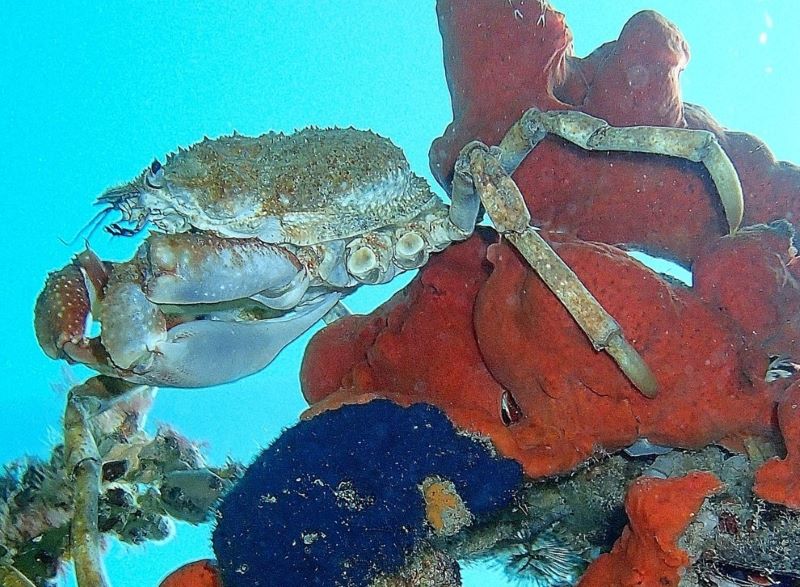Migration – when people hear this term, they usually picture herds of mammals (including people) or flocks of birds en route to places where they can find better conditions. However, did you know that Melbourne has a migration of its own in its underwater backyard? Giant Spider Crabs (Leptomithrax gaimardii) put on a show every winter in Port Phillip Bay. Let me take you on a journey back to the amazing diving adventure where I witnessed this spectacular event. Don’t worry though – you won’t have to get wet!
It is a chilly and dark Friday night and I am meeting with a bunch of very enthusiastic divers. We have all been looking forward to experiencing the annual spider crab migration. It’s a first for me and even facing the 12°C water of Blairgowrie cannot dull the excitement. A nice, easy beach entry allows us to progressively get used to the water temperature before starting our actual dive under the pier. The first things we bump into are a tiny seahorse and a few stingarees, which I take as being good signs of the fascinating dive that is to come! As we swim towards the end of the pier, we cross paths with squids swimming in mid-water, porcupinefishes, big leatherjackets, colourful sea slugs and our torches reveal the vibrant colours of sponges.
I am in awe already when we reach, at last, the spider crab aggregation. Here they are, hundreds of them, hanging out in about four to five metres of water. Most of them sport broken limbs and dull, old shells that they will need to get rid of within the next few weeks in order to grow bigger, this being the purpose of their migration. Crabs like to blend in and they tend to pick up bits and pieces from the sea floor and stick them on their shells in order to increase their camouflage. A few of them even ‘wear’ sponges on their heads and backs, ironically making them stand out even more as I am trying to spot the odd ones out to create better shots. As I focus on taking photos, a curious octopus cruises by to check me out.

This is only one of the few dives I was lucky enough to take part in during this yearly phenomenon. The other dives allowed me to witness the crabs’ movements and behaviours further, at various times of day and in different light conditions. Along with that, I was able to discover bizarre-looking critters, including tassled anglerfishes and stargazers, to name a few. I was amazed to observe the big piles that spider crabs often form at this season, sometimes reaching more than a metre in height, as they seek safety in numbers.

Towards the end of the migration, the last crabs switch from the sandy sea floor to the pylons and sponge gardens on the walls of the pier. This provides the now more-isolated crabs with better protection. When they moult, the crabs release a specific scent that predators such as rays, seals and seabirds are able to pick up and follow to gorge themselves on freshly moulted and hence very soft individuals. They need to wait a few days for their new, brighter-coloured shells to harden in order to become less vulnerable and leave the shallows to resume their solitary life in different parts of the bay.
Watching the smooth stingrays circling in between the pylons and waiting for clumsy, freshly molted crabs to fall within their reach is quite a show! So too is observing the crabs extracting themselves from their old shells: a process that seems exhausting to them and can take up to half an hour; it almost felt like I was watching a creature being born, right in front of my eyes. They usually free-fall in the water once they have managed to extract themselves from their old shells, rolling around the sea floor and looking stunned for a few minutes. Only when they are quick enough to recover their senses and climb back to the pylons are they able to escape the hungry rays. Nevertheless, more discreet critters join the frenzy. Small shrimps and seastars hang around the crabs to scrape the last bits of meat off the old shells. By this time, the bottom is strewn with discarded shells, adding to the already apocalyptic atmosphere.

There is still a lot of mystery around the annual migration, which seems to happen at different sites in different years. Aggregations have been observed at Rye, Sorrento and St Leonards in the past. Water temperatures or moon cycles might play a role in triggering the phenomenon, although this is only an educated guess. People used to believe that mating occurred after the crabs molted; this, however, is not supported by observations. There is not a lot of information about where these usually solitary animals spend the rest of the year and there have been aggregations in the forms of pyramids sighted at other times of year, whose purpose is unknown. Clearly, we still have a lot to learn about the migration and we will surely gain more information as enthusiastic divers and snorkelers continue to get in the water and share their sightings and behavioural observations on social media! Here’s hoping we get to witness a similarly spectacular show next year.
For more, follow Elodie on Twitter.
Banner image of Giant Spider Crab (Leptomithrax gaimardii) and is courtesy of Elodie Campresse.


Leave a Reply